
| Photos From Wyoming Tales and Trails This Page: Meeteetse, Pitchfork Ranch, Otto Franc, Butch Cassidy, Kirwin. |
 |

| Photos From Wyoming Tales and Trails This Page: Meeteetse, Pitchfork Ranch, Otto Franc, Butch Cassidy, Kirwin. |
 |
|
|
|
About This Site |
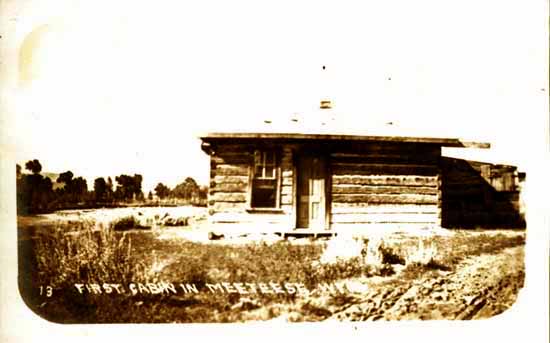 First Cabin in Meeteetse Meeteetse, "meeting place" in Shoshone, is one of the oldest settlements in the Big Horn Basin with settlement dating to the late 1870's. The town, itself, dates to the establishment of a post office and the school in 1880. The Big Horn Basin extends over four counties. Meeteetse is in Park County which was established in 1911. Cody. formed in 1896, 30 miles to the northwest, was the county seat.
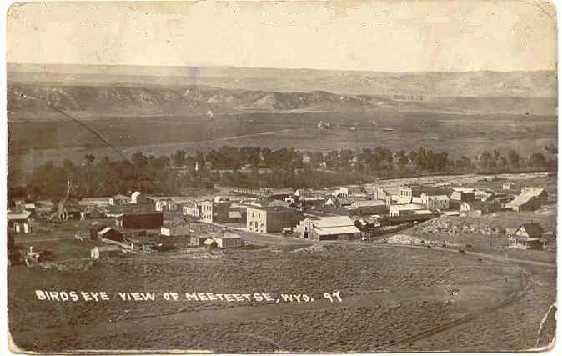 Meeteetse, 1911 Ranching in the Upper Greybull Valley started with the founding of the Pitchfork Ranch west of present day Meeteetse by Otto Franc in 1879. The ranch, at the base of the Absaroka Mountains at one time had over 250,000 acres. The ranch in the 1930's became famous, as discussed later, because of its association with photographer Charles J. Belden (1887-1966). Besides the Pitchfork, other early ranches in the area included the Two Dot and the T E. The Two Dot was established by H. J. "Two Dot" Wilson. Wilson originally started ranching in Montana. There, the town of Two Dot is named after his ranch. The name is derived from the brand. Allegedly, the brand was first applied with a hot frying pan, with one dot on the shoulder and the other on the thigh. Supposedly, Wilson never married and, thus, was less than neat about his personal appearance. There is a story that one time Wilson took a train load of cattle to Chicago. After seeing that the cattle were properly detrained, he took a cab to a local hotel and asked for a room. The desk clerk, suggesting that Wilson might be better off in a flophouse, was about to refuse him a room, when Wilson requested that the clerk check with his bank. The clerk was astonished to find that the disheveled individual before him was good for $300,000. The T E was established by Wm. F. Cody in 1895. The ranch took its name from the brand on a herd of horses purchased by Cody from Michael Russell of Deadwood, S.D. Cody and Russell had been friends from the mid 1860's in Kansas. In 1881, Meeteetse became a terminus of the old Meeteetse Trail built by the army as a stage and freight road running down from Red Lodge, Montana. The trail was the first road built in the Big Horn Basin. Red Lodge Road was ultimately extended to Lander and Rawlins. In 1893 William McNally built a house on the present site of the town.
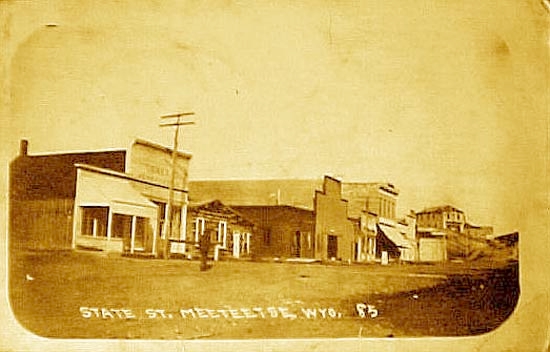 State Street, looking southeast towards Masonic Hall, early 1900's. In the 1890's, Meeteetse became the jumping off place for a minor gold rush to the upper Wood Valley. In 1885, William Kirwin discovered gold in the valley. By 1891, the Wood River Mining District had been formed. The center of the mining district was town of Kirwin 33 miles to the southest of Meeteetse and at 9,500 feet in elevation. A number of mines were created in the area including the Molly Logan, the Smuggler and the Tumlum. The Tumlum was the deepest, 250 feet deep with a steampowered hoist and three-story tall headframe. The gold was brought out by mule. At its peak the town had a hotel, a saloon operated by Andrew J. Stone, and a store owned by Charles L. Tewksbury and his wife Sarah. Tewksbury was the manager of the Wyoming Mining & Milling Co. Previously, he had been the superintendent of the Fortunatus Mining Company's short lived but expensive efforts at gold mining near Bald Mountain City west of Dayton, Wyoming. In 1895 startling information was revealed as to the discovery of a rich claim at Bald Mountain. Mining machinery was hauled up the steep slopes by ox team from Dayton. In all, Fortunatus poured in about a half million dollars into the effort, all for naught. In late 1896, mining engineer and professor of chemistry and geology at the University of Montana, Fred D. Smith, in the Engineering and Mining Journal exposed the claims as being exaggerated. Although some mining continued near Bald Mountain City as late as 1903 and a revival was tried in 1937, the gold was not commercially viable. Today, Bald Mountain City lies abandoned with nothing to show that it was the site of a gold rush. In February 1907, Kirwin was beseiged by blizzards. In one eight-day period the town was hit by over 50 feet of snow. From the slopes above, an avalanche, the "White Death" of the Rockies, roared down on the Tewksbury Store. The store's three occupants were killed. With the spring thaw, the remaining occupants of the town left. Tewksbury, however, continued to file and prove up claims. Later he advertised apparently without success for investors in Mining & Engineering World.
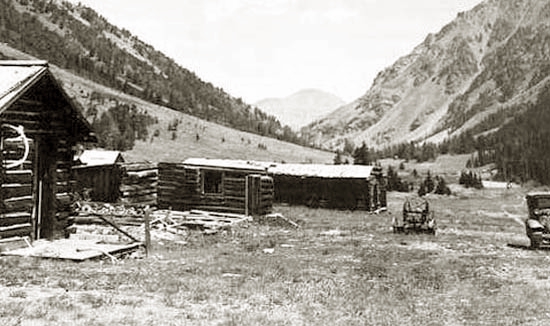 Kirwin, Wyoming, approx. 1930 In the early 1930's, Carl M. Dunrud (1891-1976) and his wife Vera (1902-2002), made an effort was made to revive Kirwin and opened the Double D Dude Ranch at Kirwin. The Wolf Mine opened. They had previously worked on the Pitchfork's Timber Creek Dude Ranch. Dunrud served as a guide in Yellowstone. There he met George P. Putnam who later became the husband of Amelia Earhart. As a result, Putnam employed Dunrud as a roper on Putnam's 1926 expedition to Greenland. On the expedition, Dunrud roped polar bears, musk oxen and walruses.
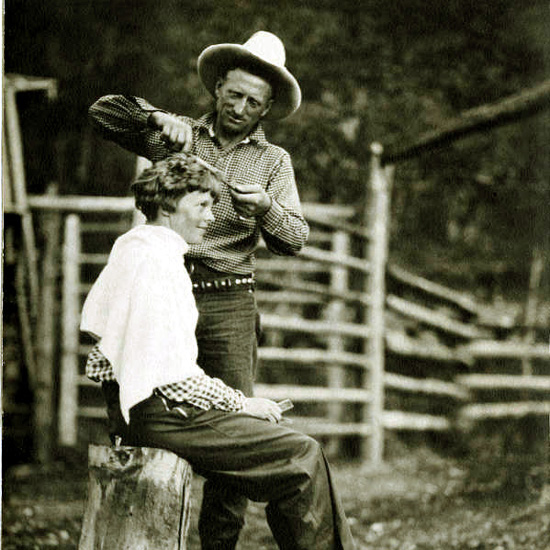 Carl M. Dunrud giving Amelia Earhart a haircut, Double D Ranch, 1934. Among the visitors to the dude ranch were Earhart and Putnam. Earhart directed that a cabin be built for her future use following her around-the-world flight. Kirwin is accessable by four-wheel drive vehicles in summer months. With the coming of World War II, the dude ranch became unviable. Dunrud a job at the Larson Ranch at Wood River and Themma taught at the Dick Creek School. In 1947, the Dunruds sold their interest in Kirwin. The Earhart cabin, located about 1/2 mile from Kirwin, remains unfinished awaiting Earhart's return.
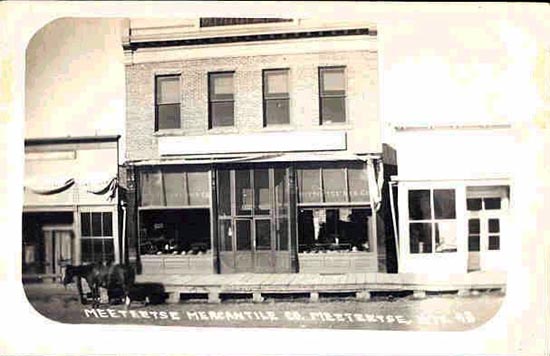 Meeteetse Mercantile, approx. 1906 The Mercantile was the Company store for the Pitchfork Ranch. The smaller one-story building on the left is a saloon. As can be seen in the next photo, porches have now been added to the saloon and mercantile.
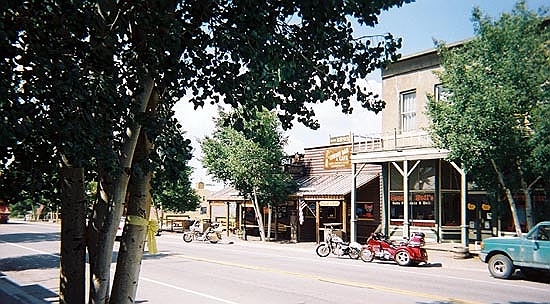 Meeteetse Cowboy Bar, photo by Geoff Dobson, 2003 The front and back bars were constructed in 1893 and brought in by freighter. The bar has 56 bullet holes in it as well as one shot gun blast. Meeteetse was also the residence of Robert Leroy Parker, a/k/a "Butch Cassidy". In 1886, while a resident of the town, Parker, using his real name, signed a petition for a new bridge. Cassidy and Franc did not get along very well. As a result of a warrant sworn out by Otto Franc for horse stealing, Parker and Al Hainer were taken into custody near Auburn in present day Lincoln County by Uinta County Deputy Sheriff Bob Calverly and John Chapman. After serving a two-year term in the Territorial Penitentiary, Cassidy returned to Meeteetse where, in 1894, Parker was arrested in front of the saloon depicted above on another warrant sworn out by Franc. Franc is alleged to have assisted in the financing of the Johnson County War.
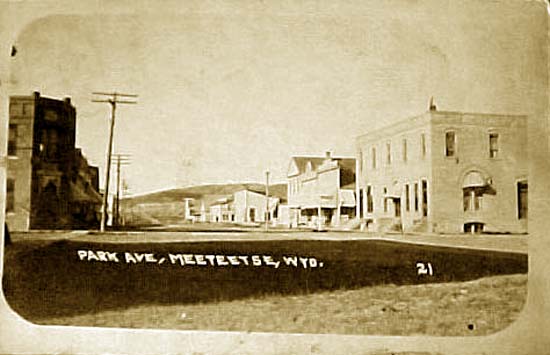 Park Avenue, looking northeast towards State St., approx. 1906. The First National Bank building is on the left. See next photo.
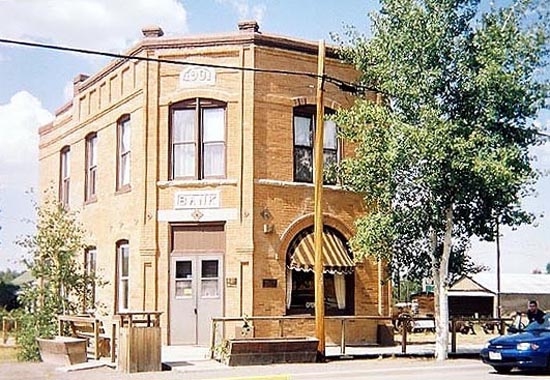 First National Bank of Meeteetse Building, 2003, photo by Geoff Dobson The bank was established in 1901 by merchant and postmaster Angus J. McDonald, stockmen Adam W. Hogg and Harris E. Cheeseman. The building, now on the National Register of Historic Places, housed the bank on the first floor until 1975. The second floor served as a meeting place for the Town Council and housed the telephone company. The building is now used as a museum. Meeteetse like many a town in Wyoming is laid back. The story is still told of one bank manager, on a day that business was slow, who decided to sneak out the back door and dip his fishing line in the nearby Graybull River. While he was so occupied, a state bank examiner arrived and found the front door unlocked and no one in the bank. The examiner decided to teach the manager a lesson and reached over the banking counter and set off the alarm. About two minutes later a waitress from a nearby saloon arrived with two beers. Next page: Meeteetse continued. |